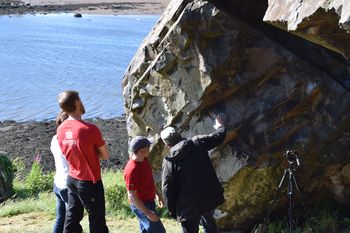ACCORD with Rock-Climbers at Dumbarton Rock
ACCORD project, 2017. https://doi.org/10.5284/1030286. How to cite using this DOI
Data copyright © ACCORD project unless otherwise stated
This work is licensed under the ADS Terms of Use and Access.
Primary contact
Dr
Stuart
Jeffrey
Research Fellow
Glasgow School of Art
Digital Design Studio
The Hub
Pacific Quay
Glasgow
G51 1EA
Scotland
Tel: +44 (0) 141 566 1465
Resource identifiers
- ADS Collection: 1964
- DOI:https://doi.org/10.5284/1030286
- How to cite using this DOI
Introduction

|
ACCORD was an AHRC funded research project that took place from October 2013 to March 2015 and was a collaboration between the Digital Design Studio at the Glasgow School of Art, the University of Manchester, the Royal Commission on the Ancient and Historical Monuments of Scotland and Archaeology Scotland. In the summer of 2014 the ACCORD project worked together with communities across Scotland to co-design and co-produce 3-Dimensional digital models of heritage places and monuments. We explored how forms of community-based social value associated with sites and places can be addressed and transformed through engagement with 3D digital technologies. The project worked together with 10 community groups across Scotland that have ongoing relationships to heritage places.
Full project details including references to methodology are available from the main ACCORD programme pages.
The ACCORD team worked with a group of rock-climbers at the site of Dumbarton Rock, known as 'Dumby' in climbing circles, from the 8th to 10th of July 2014. Together we recorded and modelled the cliff face in the north-west sector of the Rock, and some of the boulders lying beneath it. The boulders were the 'Eagle' and 'Sea' boulders, a rock-climbing route known as 'Pongo' on the 'Home Rule' boulder, and some graffiti incised into the boulders. We used the technologies of photogrammetry, Reflectance Transformation Imaging (RTI) and terrestrial LiDar laser scanning (for more information on these technologies please see the ACCORD project overview page).






